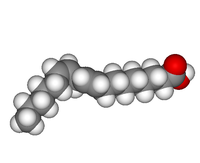
Photo from wikipedia
The chemistry of the phenolic compounds found in virgin olive oil (VOO) is very complex due, not only to the different classes of polyphenols that can be found in it,… Click to show full abstract
The chemistry of the phenolic compounds found in virgin olive oil (VOO) is very complex due, not only to the different classes of polyphenols that can be found in it, but, above all, due to the existence of a very specific phenol class found only in oleaceae plants: the secoiridoids. Searching in the Scopus data base the keywords flavonoid, phenolic acid, lignin and secoiridoid, we can find a number of 148174, 79435, 11326 and 1392 research articles respectively, showing how little is devote to the latter class of compounds. Moreover, in contrast with other classes, that include only phenolic compounds, secoiridoids may include phenolic and non-phenolic compounds, being the articles concerning phenolic secoiridoids much less than the half of the abovementioned articles. Therefore, it is important to clarify the structures of these compounds and their chemistry, as this knowledge will help understand their bioactivity and metabolism studies, usually performed by researchers with a more health science's related background. In this review, all the structures found in many research articles concerning VOO phenolic compounds chemistry and metabolism was gathered, with a special attention devoted to the secoiridoids, the main phenolic compound class found in olives, VOO and olive leaf.
Journal Title: Critical reviews in food science and nutrition
Year Published: 2022
Link to full text (if available)
Share on Social Media: Sign Up to like & get
recommendations!